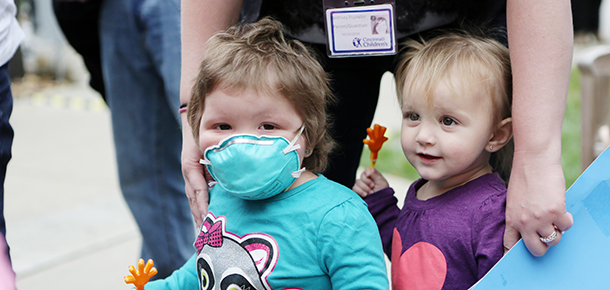If your kids tend to spend a lot of time outdoors (and they should!), parents should consider taking extra precautions to help them avoid potential infections from tick bites. This is especially true if you live in or are visiting a high-risk geographic area. Ticks can carry a variety of infections. Lyme disease is one of the most common infections from a tick bite, and is becoming more prevalent as the tick population continues to grow. Lyme disease is caused by a bacteria called Borrelia burgdorferi. As an infectious diseases doctor, here are the top things I like for parents to know about it:
10 Things for Parents to Know About Ticks and Lyme Disease:
1. Ticks are around all year long and are more prevalent in certain areas
The risk for tick bites is year-round. Lyme disease cases tend to increase in the spring months, peak in the summer, and decrease in the fall and winter seasons. Ticks like to hang out in tall grass and wooded areas. And while ticks that cause Lyme disease are most prevalent in the Northeastern, Mid-Atlantic and Central regions of the U.S., there are many tick species that can be found pretty much anywhere in the United States. The CDC has a useful map for reference.
2. The incidence of Lyme disease is increasing
In Ohio and around the country, the tick population is growing, which means the incidence of Lyme disease is rising too. In fact, in the early 1990s, Ohio Department of Health only reported a couple of cases in Ohio annually. Now there are over 100 confirmed cases each year. In 2021, 583 confirmed cases were reported. We can attribute some of this to climate change. In other words, the weather changes alter the ticks’ life cycles and not as many ticks are dying off in the winter. This allows them and the animals they feed off of in nature — like mice and deer — to spread beyond their normal geographic area and become more common in Ohio.
3. Kids are most at-risk
Kids ages 5-14 are most at-risk for Lyme disease. This is because they spend the most time outdoors and tend to do things like roll around in the grass. They may also not notice or look for a tick on their bodies. Hunters, farmers, gardeners, hikers, campers, and those who live by wooded areas are also more likely to get bitten.
4. Not all ticks carry Lyme disease
It’s important to note that not all species of ticks carry Lyme disease. In Ohio, the bacteria that causes Lyme disease, Borrelia burgdoferi, is transmitted from bites of infected Ixodes scapularis (or blacklegged) ticks. Typically, infections in humans occur after bites from the smaller, younger blacklegged ticks called nymphs. They’re tiny — about 2 millimeters long or the size of a pinhead. You can still get Lyme disease from adult ticks, but you’re more likely to see them and pull them off. The Ohio Department of Health has a great reference chart to help identify and understand the different sizes of ticks in our area.
5. It takes 3-4 days for Lyme disease to transmit
The good news is that it can take 3-4 days after an infected tick’s bite for Lyme disease to be transmitted. So, if you’re diligently checking for ticks when in high-risk areas, you’ll be less likely to get Lyme disease from the bite of an infected tick.
6. Lyme disease symptoms can vary
Symptoms of Lyme disease can vary depending on how much has time has passed since your child was bitten. Usually, the first symptoms show up within one month after the bite. They can include a “bull’s eye” rash known as erythema migrans, headache, fever, muscle aches, and swollen lymph nodes, to name a few. Untreated Lyme disease can progress over a period of weeks into symptoms that include facial nerve palsy, abnormal heart rhythms, and nerve pain. If left untreated, some children develop late Lyme disease that commonly manifests as arthritis. This is often characterized by a swollen, tender knee. Other complications like meningitis are rare in Lyme disease.
7. There is testing available
Lyme disease is a bacterial infection that can be diagnosed with a blood test. It can take up to a month for an infected patient to make enough antibodies to have a positive test. If you test for Lyme disease too early, you can get a false negative result. Some patients who have other bacterial infections or autoimmune disease can have a false positive test. Additionally, there are other infections that can look like Lyme disease so your doctor may choose to evaluate for other problems, especially if you live in an area where Lyme disease is rare.
8. Antibiotic treatment is effective
Children can often be treated with oral antibiotics for Lyme disease. More severe symptoms such as abnormal hearth rhythms may require intravenous (IV) therapy. The sooner children receive antibiotics, the better their prognosis will be. Most patients who are treated for Lyme disease recover completely.
9. Prevention is key
We want our kids to enjoy the great outdoors — so how can we let them do that while also trying to avoid ticks? Here are a few prevention tips:
– When hiking, walk in the middle of the trails
– Avoid tall grass
– Use repellent with DEET
– Wear long pants, sleeves and socks
– Wear light colors so that you can see the ticks on your clothes
– Shower soon after being outside so that tics don’t have time to attach to your child’s skin
– Do a tick check when you get home, and every couple of days
10. Remove ticks safely
If you do spot a tick attached to your child’s skin, use fine-tipped tweezers. Do not apply petroleum jelly or use a hot match to make the tick stop biting the skin. It does not always work and you can accidentally burn your child!
To learn more about our Division of Infectious Diseases, or to schedule an appointment, please call 513-636-7499.






